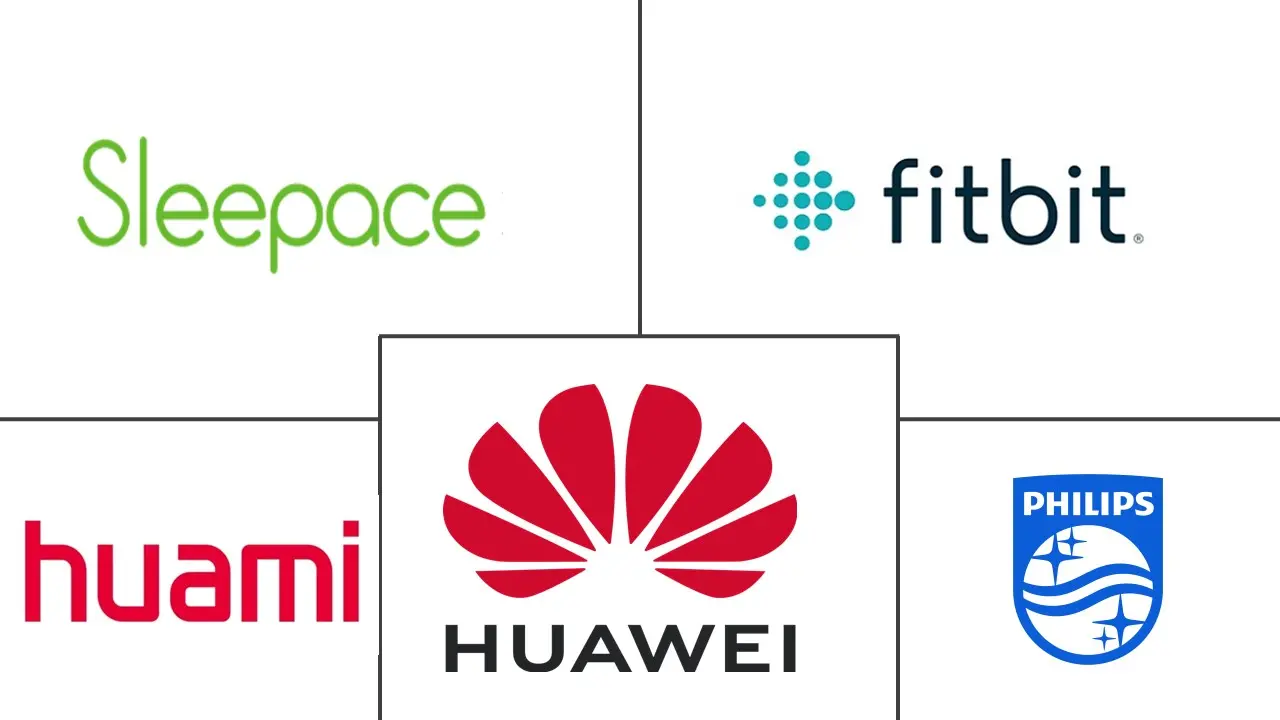Global Wearable Sleep Trackers Market Size and Share
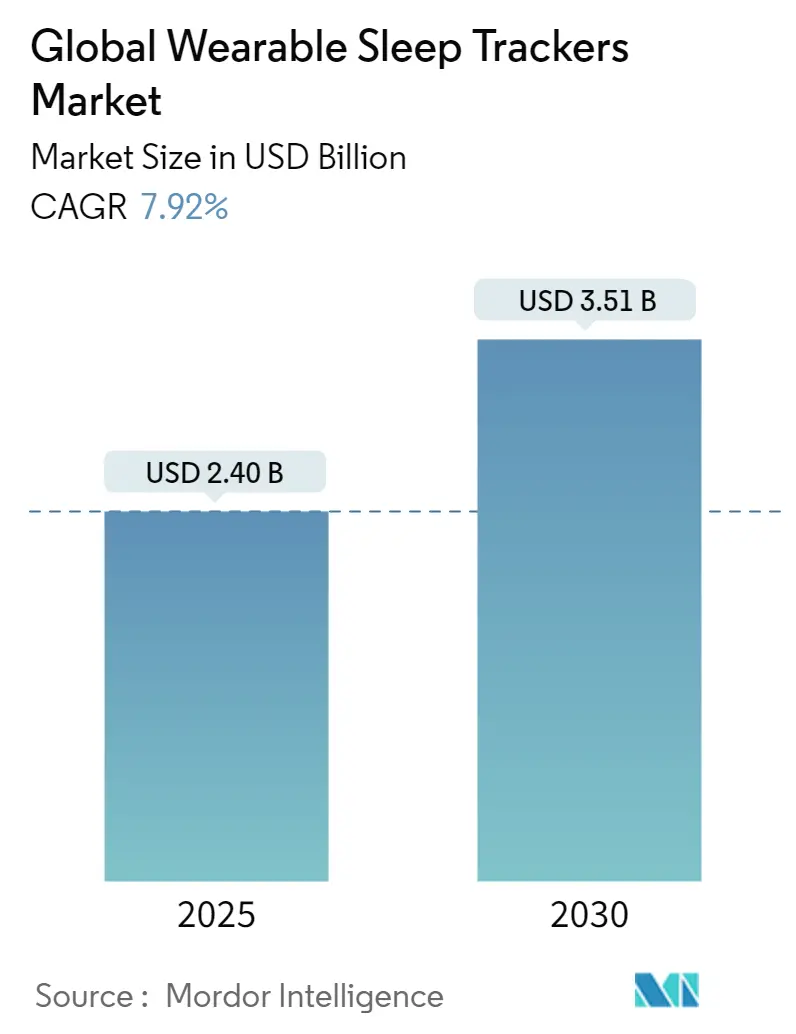
Global Wearable Sleep Trackers Market Analysis by Mordor Intelligence
The Global Wearable Sleep Trackers Market size is estimated at USD 2.40 billion in 2025, and is expected to reach USD 3.51 billion by 2030, at a CAGR of 7.92% during the forecast period (2025-2030).
Unprecedented changes have occurred in people's lives as a result of the COVID-19 epidemic. For a lot of people, it has resulted in a lot of worry, anxiety, and worries about their health, social isolation, job, finances, and the difficulty of juggling work and family responsibilities. Sleep disruption and market growth are likely consequences of such a momentous life event. According to the study titled "Increased sleep duration and delayed sleep timing during the COVID-19 pandemic" Scientific Reports in July 2022, for 32% of users overall during the pandemic's acute phase, weekday sleep length increased by more than 20 minutes, while 17% of users reported sleeping less than normal. In addition, nearly all nations experienced considerable changes in sleep schedules in the second quarter (April to June) of 2020, just after the World Health Organization declared COVID-19. Thus, all people in every nation around the globe experienced changes in their sleep patterns during COVID-19, which had a substantial impact on the expansion of the market for sleep tracking devices.
The major factor attributing to the growth of the market is the rising incidence of sleep disorders like sleep apnea, insomnia, and narcolepsy globally. Therefore, the increasing variety of different types of wearable sleep trackers is expected to provide better and healthy sleep to people suffering from these disorders. According to the study titled "Prevalent, incident, and persistent insomnia in a population-based cohort tested before (2018) and during the first wave of COVID-19 pandemic (2020)" published in the Sleep in January 2022, Between 2018 and 2020, the prevalence of insomnia grew by 26.7%, from 25.4% to 32.2% (symptoms), and from 16.8% to 19% (syndrome). Thus, growing prevalence of insomnia across the globe the demand for sleep trackers is expected to increase to monitor the overall sleep performance, thereby boosting the market growth.
Health awareness, technological advancements, new product launches, and increasing research and development activities across the globe boost the market growth. For instance, in August 2021, Muse unveiled Muse S, the updated version of their well-liked EEG meditation and sleep headband. This improved plush brain-sensing headband uses real-time biofeedback to help people learn the art of meditation, fall asleep, stay asleep, and now go back to sleep if they wake up in the middle of the night. Thus, the growing prevalence of sleep disorders and product launches by the key market players support the market growth. However, the high cost of devices and increasing demand for nonwearable device trackers restrain the market growth.
Global Wearable Sleep Trackers Market Trends and Insights
Wrist Bands Segment is Expected to Grow at a Faster Rate OverThe Forecast Period
The fast growth of the segment is attributed to the vast usage of wristbands and their availability in many brands. The comfort of the wristbands is one more reason for the increasing growth rate. Apart from the advantages of the wrist bands, the factors boosting the market are the increasing patient pool of sleep disorders. According to sleepassociation.org, in June 2020, Obstructive sleep apnea (OSA) is a well-known disorder that affects up to 20% of the world's population annually. Usually misdiagnosed and untreated, it is a dangerous and perhaps fatal sleep disorder. Moreover, according to the study titled "Performance of Four Commercial Wearable Sleep-Tracking Devices Tested Under Unrestricted Conditions at Home in Healthy Young Adults" published in the Dovepress in November 2021, study comprised the Polar Vantage V Titan, Fitbit Inspire HR, Oura ring, and Fatigue Science Readiband. Every technology detected sleep more effectively than wake, and most devices exceeded actigraphy in identifying wake. On nights with more consistent sleep patterns, devices worked best. Thus, the effectiveness of the wristband in tracking sleep is expected to expand the segment growth.
Additionally, product launches by the key market players is anticipated to boost the market growth. For instance, in August 2022, the Samsung Galaxy introduced the Watch 5 and Watch 5 Pro with advance sleep tracking features. Additionally, in April 2022, the Singaporean company BUZUD, Fosun Trade Medical Device, has unveiled its next-generation smartwatches, the DM01 and DM02, which use SpO2 technology to measure blood oxygen levels and track sleep quality. Thus, all aforementioned factors expected to boost the segment growth over the forecast period.
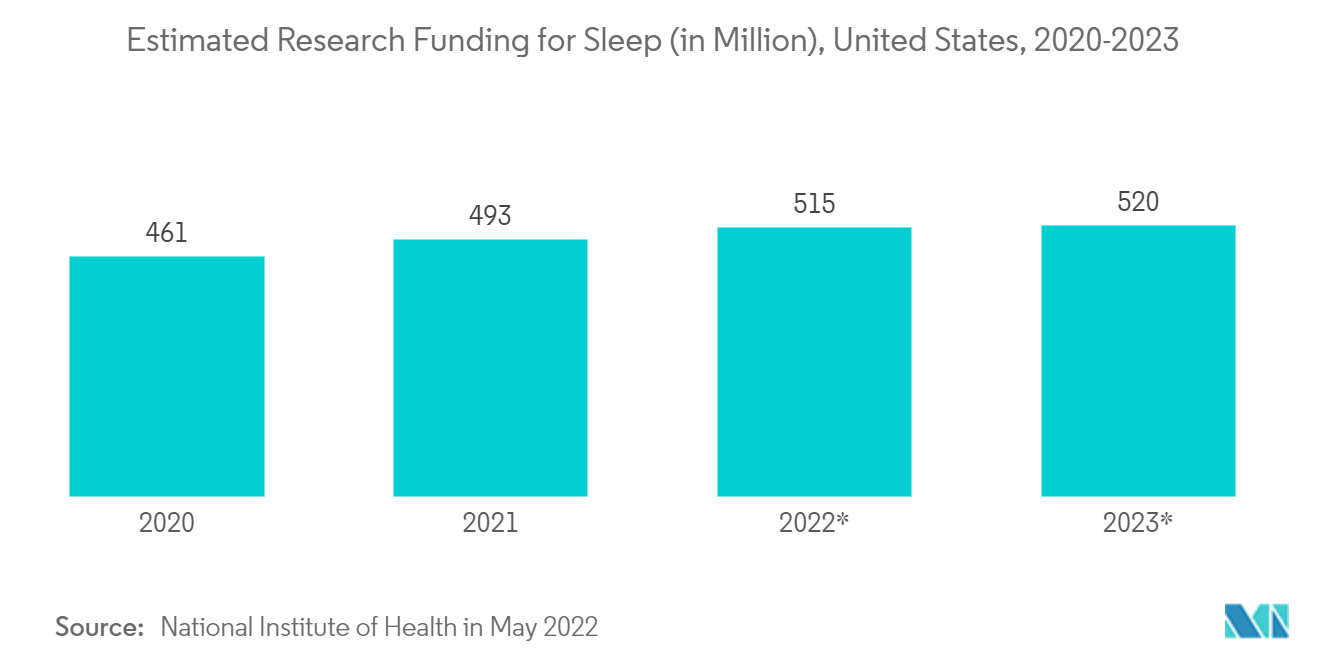
North America Dominates the Market and Expected to do Same in the Forecast Period
North America is expected to dominate the overall Wearable Sleep Trackers market, throughout the forecast period. The largest share is mainly due to the presence of a larger patient pool and the increasing geriatric population. In the North American region, the United States holds the largest market share due to the factors such as the increasing number of geriatric populations, along with a growing patient pool in the country. According to the American Academy of Sleep Medicine 2020, up to 20% of people in the United States experience adjustment insomnia each year, which is often brought on by stress. Poor sleep patterns in kids increase their risk of behavioral insomnia, which 30% of kids experience. About 3% of the population suffers from insomnia, which is brought on by prescription medications, substance addiction, underlying medical illnesses, and mental health issues. Anemia, obesity, drug withdrawal, depression, and depression are a few of the specific conditions that might induce insomnia.
Moreover, the presence of key market players and the research and development of new drugs and product launches are expected to boost the growth of the market studied. For instance, in October 2021, Oregon created a headband that may improve both sleep and the cleaning that comes with it. Researchers plan to test the device on 90 people in a new USD 4.3 million projects funded by the United States Department of Defense. Additionally, in August 2022, Interaxon, a wearable technology startup based in Toronto, has closed a USD12.1 million Series C funding to enable the introduction of a membership model for its Muse brain sensing headband. Thus, all aforementioned factors are expected to boost the segment growth over the forecast period.
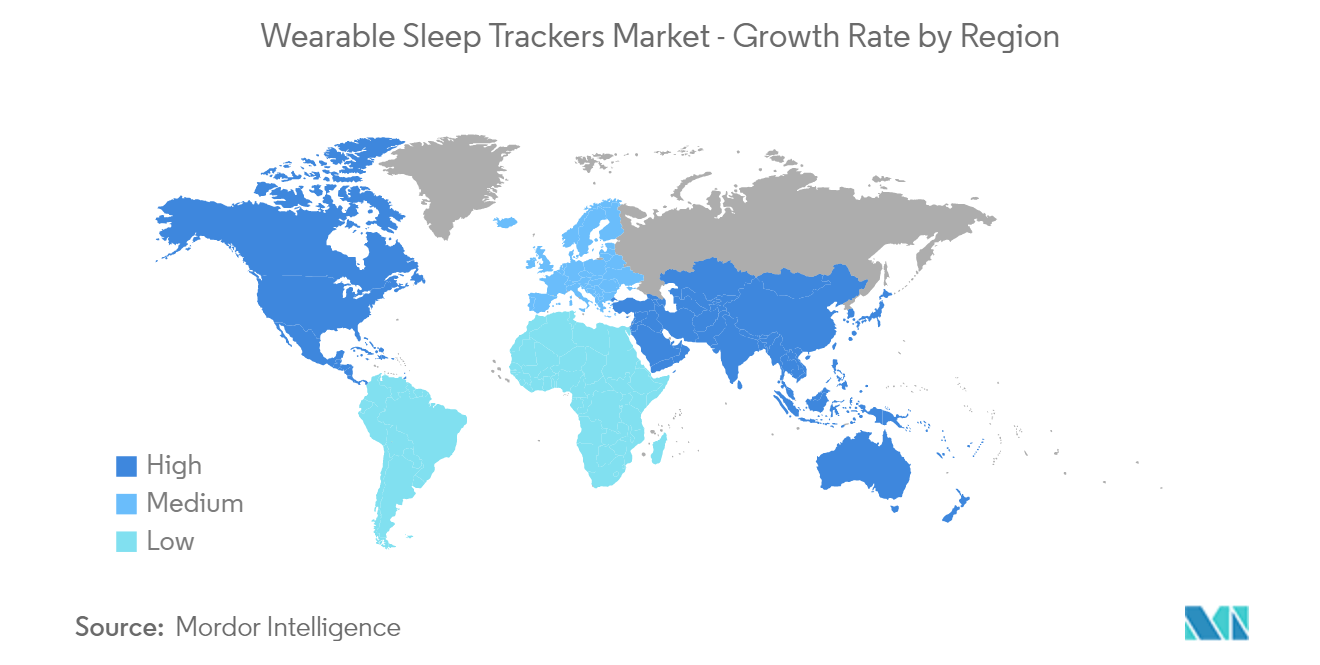
Competitive Landscape
The Wearable Sleep Trackers market is moderately competitive. A few of the crucial approaches followed by players functioning in the market are, product advancement, invention, acquisitions and mergers. Some of the companies which are currently domianting the market are Koninklijke Philips N.V, Huami Corporation, Fitbit, Inc., Huawei Device Co., Ltd. , Sleepace.
Global Wearable Sleep Trackers Industry Leaders
-
Koninklijke Philips N.V
-
Fitbit, Inc.
-
Sleepace
-
Huami Corporation
-
Huawei Device Co., Ltd.
- *Disclaimer: Major Players sorted in no particular order
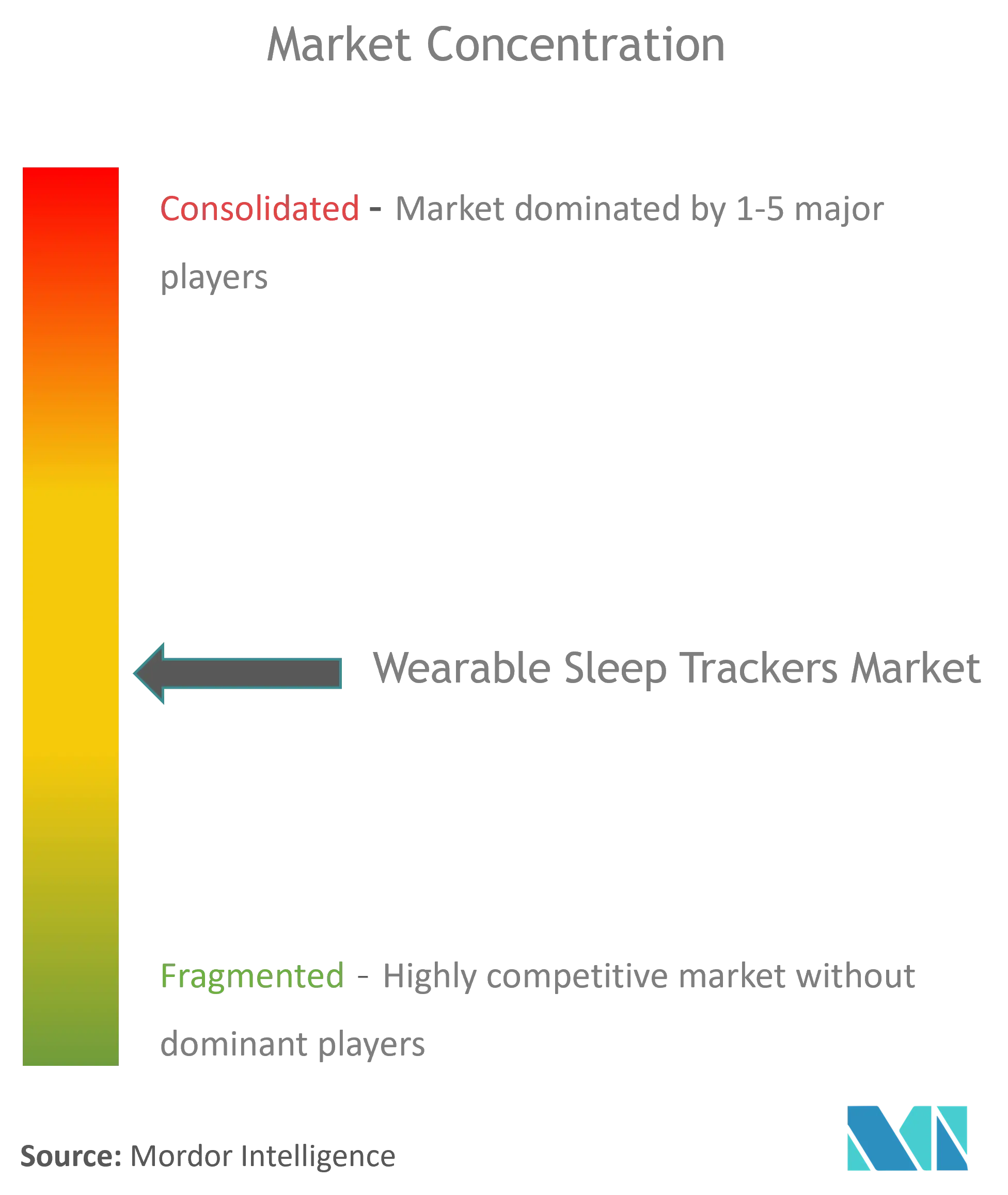
Recent Industry Developments
- In July 2022, Boult Audio has marked its entry into the wearable segment by the launch of two smartwatches called Boult Drift and Boult Cosmic Smartwatch in India. These devices also feature sleep trackers that provide detailed analysis of sleep.
- In May 2022, StimScience, introduced its new sleep tracking product, Somnee. It is an electronic headband that employs non-invasive, customised brain stimulation to help individuals fall asleep.
Global Wearable Sleep Trackers Market Report Scope
As per the scope of the report sleep tracking device takes the data regarding one's sleep and gives a complete analysis of it. It takes note of the time of sleep to the person's heart rate, breathing, snoring as well as the temperature; humidity of the person's surrounding environment or the room. The Wearable Sleep Trackers market is segmented by Product Type (Wrist Bands, Head Bands, Others), Application (Insomnia, Sleep Apnea, Others), and Geography (North America, Europe, Asia-Pacific, Middle East and Africa, and South America). The report also covers the estimated market sizes and trends for 17 different countries across major regions globally. The report offers the value (in USD million) for the above segments.
| Wrist Bands |
| Head Bands |
| Others |
| Insomnia |
| Sleep Apnea |
| Others |
| North America | United States |
| Canada | |
| Mexico | |
| Europe | Germany |
| United Kingdom | |
| France | |
| Italy | |
| Spain | |
| Rest of Europe | |
| Asia-Pacific | China |
| Japan | |
| India | |
| Australia | |
| South Korea | |
| Rest of Asia-Pacific | |
| Middle-East and Africa | GCC |
| South Africa | |
| Rest of Middle-East and Africa | |
| South America | Brazil |
| Argentina | |
| Rest of South America |
| By Product Type | Wrist Bands | |
| Head Bands | ||
| Others | ||
| By Application | Insomnia | |
| Sleep Apnea | ||
| Others | ||
| Geography | North America | United States |
| Canada | ||
| Mexico | ||
| Europe | Germany | |
| United Kingdom | ||
| France | ||
| Italy | ||
| Spain | ||
| Rest of Europe | ||
| Asia-Pacific | China | |
| Japan | ||
| India | ||
| Australia | ||
| South Korea | ||
| Rest of Asia-Pacific | ||
| Middle-East and Africa | GCC | |
| South Africa | ||
| Rest of Middle-East and Africa | ||
| South America | Brazil | |
| Argentina | ||
| Rest of South America | ||
Key Questions Answered in the Report
How big is the Global Wearable Sleep Trackers Market?
The Global Wearable Sleep Trackers Market size is expected to reach USD 2.40 billion in 2025 and grow at a CAGR of 7.92% to reach USD 3.51 billion by 2030.
What is the current Global Wearable Sleep Trackers Market size?
In 2025, the Global Wearable Sleep Trackers Market size is expected to reach USD 2.40 billion.
Who are the key players in Global Wearable Sleep Trackers Market?
Koninklijke Philips N.V, Fitbit, Inc., Sleepace, Huami Corporation and Huawei Device Co., Ltd. are the major companies operating in the Global Wearable Sleep Trackers Market.
Which is the fastest growing region in Global Wearable Sleep Trackers Market?
Asia-Pacific is estimated to grow at the highest CAGR over the forecast period (2025-2030).
Which region has the biggest share in Global Wearable Sleep Trackers Market?
In 2025, the North America accounts for the largest market share in Global Wearable Sleep Trackers Market.
What years does this Global Wearable Sleep Trackers Market cover, and what was the market size in 2024?
In 2024, the Global Wearable Sleep Trackers Market size was estimated at USD 2.21 billion. The report covers the Global Wearable Sleep Trackers Market historical market size for years: 2019, 2020, 2021, 2022, 2023 and 2024. The report also forecasts the Global Wearable Sleep Trackers Market size for years: 2025, 2026, 2027, 2028, 2029 and 2030.
Page last updated on:
Global Wearable Sleep Trackers Market Report
Statistics for the 2025 Global Wearable Sleep Trackers market share, size and revenue growth rate, created by Mordor Intelligence™ Industry Reports. Global Wearable Sleep Trackers analysis includes a market forecast outlook for 2025 to 2030 and historical overview. Get a sample of this industry analysis as a free report PDF download.
